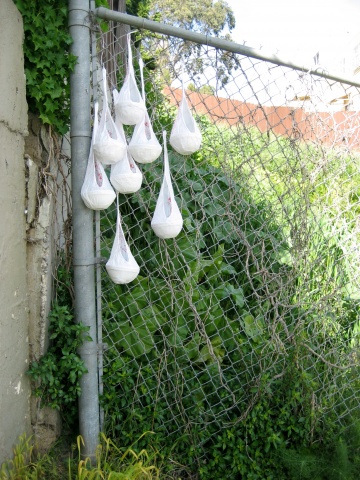
Songbird Take-Out Shelters
2008
Plastic take-out bags, bowls
Alienated and excluded from urban architecture, San Francisco’s roughly 2,600 homeless citizens must migrate throughout the city in a constant quest for food, shelter and county services. Likewise, exhausted and famished northbound migratory songbirds are forced to bypass San Francisco’s urban sprawl—opting instead to continue north to Marin County in favor quiet nesting areas and food. Relegated to the margins of urban architecture, both San Francisco’s homeless citizens and its few remaining songbirds must build their communities and find comfort, privacy and shelter amongst cold concrete corners, chain link fences and garbage strewn streets.
Built from urban detritus like plastic bags, tarps, and bits of rope, my project lays claim to the exterior, exclusionary walls and fences of the urban environment. Creating comfort in the threatening and inhospitable; interiors on the anterior; privacy in public; and championing impermanence over the concrete—my project attempts to reverse human and avian expectations and interactions with urban architecture by embracing the nomadic lifestyle of both communities.
The Songbird Take-Out Shelter
Until 2007, San Francisco citizens used approximately 180 million plastic bags a year. Non-biodegradable and petroleum-based, San Francisco’s annual diet of plastic bags demanded approximately 774,000 gallons of oil for their production.1 Translucent and shimmery in sunlight, the plastic bags also resemble the preferred food sources of local bird populations and marine life—contributing to countless deaths of avian and marine animals through strangulation and/or ingestion. Despite a 2007 ordinance outlawing the use of plastic bags, San Franciscans continue to tote their “take-out” and groceries in plastic and city streets continue to be strewn with these fluttering hazards.
Constructed from take-out bags, my birdhouses reconfigure these plastic urban menaces into comfortable nesting shelters for wary migratory songbird species like swallows and martins. Able to be hooked on high fences or wrought iron window coverings, this shaded colony of nests is distanced from the city’s urban traffic and commotion. Directly above Cohen Alley’s oasis of plants, these nests also allow songbirds to feast on their preferred “take-out” of grubs and insects.
Built from urban detritus like plastic bags, tarps, and bits of rope, my project lays claim to the exterior, exclusionary walls and fences of the urban environment. Creating comfort in the threatening and inhospitable; interiors on the anterior; privacy in public; and championing impermanence over the concrete—my project attempts to reverse human and avian expectations and interactions with urban architecture by embracing the nomadic lifestyle of both communities.
The Songbird Take-Out Shelter
Until 2007, San Francisco citizens used approximately 180 million plastic bags a year. Non-biodegradable and petroleum-based, San Francisco’s annual diet of plastic bags demanded approximately 774,000 gallons of oil for their production.1 Translucent and shimmery in sunlight, the plastic bags also resemble the preferred food sources of local bird populations and marine life—contributing to countless deaths of avian and marine animals through strangulation and/or ingestion. Despite a 2007 ordinance outlawing the use of plastic bags, San Franciscans continue to tote their “take-out” and groceries in plastic and city streets continue to be strewn with these fluttering hazards.
Constructed from take-out bags, my birdhouses reconfigure these plastic urban menaces into comfortable nesting shelters for wary migratory songbird species like swallows and martins. Able to be hooked on high fences or wrought iron window coverings, this shaded colony of nests is distanced from the city’s urban traffic and commotion. Directly above Cohen Alley’s oasis of plants, these nests also allow songbirds to feast on their preferred “take-out” of grubs and insects.




